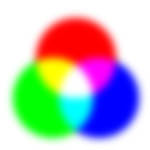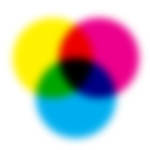With color, there are two main systems. These systems are the light or additive color system and the pigment or subtractive color system. Computer screens use the additive color system. They use projected light to create colors. Printers use pigment or the subtractive system to create colors. Many of the discrepancies noticed from an image on screen and that same image printed on paper or a shirt can be explained and in many cases avoided by understanding these two systems.
What Color Really Is
Visible light is the very small portion of the electromagnetic spectrum that most humans can see. It is composed of energy waves of different lengths. As these wavelengths very, different colors of light is perceived. White light like sunlight actually contains many colors. If viewed through a prism or more commonly, a few raindrops, those colors are separated and can be viewed as a rainbow.
Additive Color System (RGB)

The additive color system works with projected light. Computer monitors and televisions use this model. Light comes from the screen and is viewed by people directly with nothing reflecting the light.
The primary colors of the additive system are Red, Green, and Blue. When mixed, red and green create yellow, green and blue create cyan, and blue and red create magenta. When all three primaries are combined, white light is created. Black is produced by the absence of any light.
Computer monitors use tiny dots of red, green, and blue light to create all of the colors seen on screen. By varying the intensity of each dot of light, a wide range of colors can be produced.
Subtractive Color System (CMY)

Objects that do not emit light create color by absorbing some colors of the light falling on the object and reflecting rest of the colors back to the viewer. Because these objects absorb or subtract color from white light, this process is called subtractive color. A blade of grass outside does not project green light. It projects no light at all. Instead, the white light from the sun hits the grass. The grass absorbs varying amounts of the other colors of light, but it reflects back green. That is how the grass is perceived as green.
The primary colors of the subtractive color system are cyan, magenta, and yellow. By combining these colors in varying degrees, a large number of colors can be reproduced. This is process used by printers, magazines, and photographers, or anyone else using dyes or pigments to create color.
In theory, combining all three primary colors will create black. Because so few color models are perfect, many printers add black ink to allow for deeper and richer dark colors. The black plate in offset printing was the Key plate. This is where the K has been added to CMYK.
Different Gamuts
While both systems can be used to create color, the range of colors created by each system varies. The additive system (RGB) can create a much wider and more vibrant range of color. Below is an example of the same color image simulating the differences in RGB and CMYK modes.

If this image were to be printed using CMYK inks, the differences in the two halves would be far less noticeable. This is why you can create an incredibly vibrant green on screen, but when it is printed, it may look darker and less brilliant.
In the example below the image is shown in both RGB and CMYK. The differences can be drastic.

Avoiding Printing Surprises
To lessen the differences in an image on screen and the one printed by a printer, there are a couple of steps that can be taken.
Know the color space. Make sure that when creating an image, only colors that can be reproduced by a CMYK printer are used. Many graphics programs have a color mode or workspace setting that can be changed from RGB to CMYK. Try creating in a CMYK environment or with CMYK color mixers.
Some RIP software or programs process RGB files better than CMYK. If that is the case, create the image using CMYK and convert it to RGB before saving.